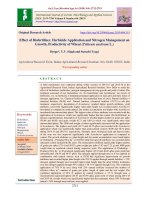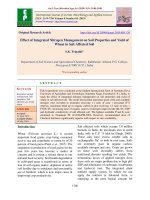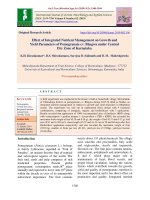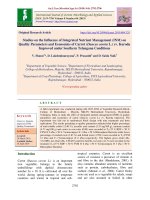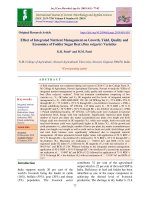Effect of integrated nutrient management on growth parameters of fennel (Foeniculam valgare Mill.) in inceptisol
Bạn đang xem bản rút gọn của tài liệu. Xem và tải ngay bản đầy đủ của tài liệu tại đây (259.27 KB, 6 trang )
Int.J.Curr.Microbiol.App.Sci (2018) 7(3): 1067-1072
International Journal of Current Microbiology and Applied Sciences
ISSN: 2319-7706 Volume 7 Number 03 (2018)
Journal homepage:
Original Research Article
/>
Effect of Integrated Nutrient Management on Growth Parameters of
Fennel (Foeniculam valgare Mill.) in Inceptisol
Y.V. Singh1, D.K. Srivastava3, Pavan Singh1, S.K. Varma2,
A.K. Kanthle1 and D. Mishra1
1
Department of Soil Science and Agricultural Chemistry, 2Department of Agronomy, Institute
of Agricultural Sciences, Banaras Hindu University, Varanasi 221005, India
3
Council of Science & Technology, U.P. Lucknow - 226 018 (U.P.), India
*Corresponding author
ABSTRACT
Keywords
STCR-IPNM, Fennel,
Plant height, Number of
branches, Fresh weight
and dry weight (gm) etc.
Article Info
Accepted:
10 February 2018
Available Online:
10 March 2018
Studies on soil test crop response based on integrated plant nutrient
management system (STCR-IPNM) were conducted for the growth
parameters of fennel on Inceptisol of agricultural research farm, Banaras
Hindu University, Varanasi during Rabi 2017-18. Objective is to study the
effect of integrated nutrient management on growth parameters of Fennel in
Inseptisol. Integrated application of N.P.K 120-60-45 kg ha-1 with F.Y.M
10 t ha-1 in strip IIIrd showed higher values of all the growth parameters
attributes, viz., - plant height, number of branches/plant, fresh weight and
dry weight of following strip IInd and strip Ist.
Introduction
Fennel (Foeniculum vulgare Mill.) is one of
popular seed spice in India mainly grown in
rabi season, locally known as saunf belongs to
the family Apiaceae (Umbelliferae). Fennel is
native to Southern Europe and Mediterranean
region. It is a perennial, but is grown as annual
or biannual. It is cultivated throughout the
temperate and subtropical regions of the world
for its aromatic seeds which are used for
culinary purpose. Plants have dark green or
bronze wispy leaves with the yellow flowers
on compound umbels and are cross pollinated.
It is tall, hardy and erect growing herb and
grows from 90-150 cm. Among the aromatic
plants, we consider the fennel, in which its
seeds
have
several
uses
(culinary,
pharmaceutical, etc).
Fennel is also highly recommended for
diabetes, bronchitis and chronic coughs,
treatment of kidney stones, and is considered
to have diuretic, stomachic and galactogogue
properties. In India, it is mainly cultivated in
the states of Gujarat and Rajasthan and to
some extent in Uttar Pradesh, Bihar, Madhya
Pradesh, Punjab and Haryana. In India, area
under fennel was 41368 ha with production of
58265 t and productivity of 1.40 t ha-1 in
1067
Int.J.Curr.Microbiol.App.Sci (2018) 7(3): 1067-1072
2010-11 (SBI, 2011). The farm yard manure
(FYM) seems to be directly responsible in
increasing crop yields either by accelerating
the respiratory process by increasing cell
permeability by hormone growth action or by
combination of all these processes.
It supplies nitrogen, phosphorus and
potassium in available forms to the plants
through biological decomposition. Indirectly it
improves physical properties of soil such as
aggregation of soil, permeability and water
holding capacity. It is prepared from the dung
of farm animals and contains all the essential
elements.
Materials and Methods
To assess the validation of fertilizer equation
for fennel developed by Soil test Crop
Response based on Integrated Plant Nutrient
Management (STCR - IPNM) were conducted
for the growth parameters of Fennel, on
Inceptisol of Agricultural Research Farm,
Banaras Hindu University, Varanasi during
Rabi 2017-18.
Physico-chemical
experimental soil
properties
of
The soil of the experimental site was sandy
loam in texture with predominance of kiolinite
type of clay minerals which taxonomically
categorized under the great group Typic
Haplustepts (old alluvium).
Soil of experimental field had 166 kg ha-1
alkaline permanganate oxidizable N (Subbiah
and Asija, 1956), 14 kg ha-1 0.5 N sodium
bicarbonate extractable P (Olsen et al., 1954),
146 kg ha-1 neutral 1N ammonium acetate
exchangeable K (Hanway and Heidel, 1952)
as described by (Jackson, 1973). 0.43%
organic carbon (Walkley and Black, 1934), pH
of 7.50 and electrical conductivity of 0.43
dSm-1 in 1:2.5 soil to water (Jackson, 1973).
Fertility gradient experiment
Prior to test crop experimentation, fertility
gradient experiment was conducted to create
soil fertility gradient using ‘inductive
methodology’ developed by Rama Moorthy et
al., (1967).
For this purpose, field was divided into three
equal rectangular strips and graded doses of
fertilizer N, P and K were applied as
N0N1P1K1 (0-40-20-15), N0N2P2K2 (0-80-4035) and N0N3P3K3 (0-120-60-45) in strip I,
strip II and strip III, respectively. Soil fertility
gradient with respect to farmyard manure
(FYM) was developed by applying FYM @ 0,
5 and 10 tonnes ha-1 in three strips across the
fertilizer applied strips. This created distinct
nine blocks (3 in each strip) in field receiving
different nutrient doses. During winter 201718, preliminary exhaustive aromatic funnel
crop (variety: African tall) was grown to
stabilize soil fertility. Twenty-four soil
samples (0-15 cm) from each strip were
collected before sowing of exhaustive
aromatic crop and analyzed for available
nitrogen, by the alkaline permanganate
method (Subbiah and Asija, 1956); available
phosphorus, by Olsen et al., (1954) and
available potassium, by the ammonium acetate
method (Hanway and Heidal, 1952) as
described by Jackson (1973).
Growth parameters
Plant height (cm), number of branches, fresh
weight and dry weight (gm) were taken 35, 75
and 110 days after sowing and five randomly
selected plants in each plot and the means
were recorded.
The data were statistically analyzed according
to a randomized block design and three
replications. Mean, SD, Sem± and CV were
calculated for significance amongst the
treatments.
1068
Int.J.Curr.Microbiol.App.Sci (2018) 7(3): 1067-1072
Test crop experimentation
After fertility gradient experiment, each strip
was divided into 24 plots to accommodate 24
treatments (21 treatments + 3 controls) making
total of 72 plots. Three blocks (comprising 8
treatments) were made within each strip. The
experiment was laid out in fractional factorial
randomized block design. The treatments
comprised of selected combinations of four
levels of nitrogen (0, 40, 80 and 120 kg N
ha-1), phosphorus (0, 20, 40 and 60 kg P2O5
ha-1) and potassium (0, 15, 30 and 45 kg K2O
ha-1) and three levels of FYM (0, 5, 10 tonnes
FYM ha-1) (Table 1). Treatments were
randomized in each strip and replicated thrice.
N was applied in three equal splits as basal
and two top dressings at crown root initiation
and maximum tillering; however, full basal
dose of P and K was applied at the time of
sowing. Test crop ‘fennel’ was grown during
2017-18. Twenty-four soil samples (0-15 cm)
were collected from each strip before sowing
of test crop fennel and analyzed for alkaline
KMnO4-N, Olsen’s-P and K the ammonium
acetate method.
Results and Discussion
Establishment of fertility gradient
Descriptive statistics of pre-sowing available
soil nutrients in surface soil is presented in
Table 2. Mean alkaline KMnO4-N of 221.02,
232.42 and 242.47 kg ha-1 were observed in
strip I, II and III, respectively. Mean Olsen’s-P
values in strip I, strip II and strip III were
14.34, 16.10 and 23.48, respectively. The
ammonium acetate method extractable-K of
206.67, 220.92 and 228.04 kg ha-1 were
recorded in strip I, II and III, respectively.
From the data, it is obvious that mean value of
the alkaline KMnO4-N, Olsen’s-P and the
ammonium acetate method extractable-K was
highest in strip III, followed by strip II and it
was lowest in strip I. Within strip variation
with respect to soil available nutrients can be
explained by coefficient of variation. A
marked fertility gradient was built up by
application of graded levels of fertilizer and
FYM. This indicates that, adequate variability
with respect to soil available N, P and K was
developed before start of test crop experiment.
Growth parameter attributes
Plant height and number of branches
The data showed that integrated nutrient
management significantly affected different
growth parameters attributes of fennel viz.,
plant height (cm) and number of branches of
fennel viz., 35, 75, and 110 day after sowing.
These result descriptive statistics of funnel
growth parameters are presented in Table 3.
During experimentation, the highest growth
parameters were obtain strip III being fertile
strip followed by strip II and the lowest in
unfertilized strip I. Mean growth parameters
of overall plots were viz., plant height (cm),
number of branches per plant, during all stages
of growth of fennel viz., 35, 75, and 110 day
after sowing. The mean value of strip I-height
(cm) (10.14, 56.10, 109.03), number of
branches (2.69, 3.64, 4.81), strip II – height
(cm) (12.07, 67.13, 117.05), number of
branches (3.11, 4.72, 5.65) and strip III –
height (cm) (14.56, 76.35, 132.19), number of
branches (4.88, 5.75, 7.41). Growth
parameters of funnel increased with the
increase in application of fertilizer N, P and K
and FYM. Increased Plant height(cm), number
of branches, fresh weight and dry weight (gm)
with application of 100 % NPK
(recommended dose) of fertilizers or
combined use of farm yard manure with
nitrogen might have been resulted because of
higher content of nutrients sufficient level that
in turn gave higher yields. The findings are in
agreement with those of Patashetti et al.,
(2002), Sankhyan et al., (2003) and Hattab et
al., (2000).
1069
Int.J.Curr.Microbiol.App.Sci (2018) 7(3): 1067-1072
Table.1 Detailed N, P and K treatment combinations used for test crop experimentation
S.N.
1
2
3
4
5
6
7
8
9
10
11
12
13
14
15
16
17
18
19
20
21
22
23
24
Treatment Combinations
N
P
K
0
3
0
3
2
2
1
3
0
3
2
1
2
1
1
3
0
3
2
2
2
2
2
3
0
3
2
2
1
2
1
3
0
1
2
2
1
1
2
3
0
2
0
2
2
1
3
2
FYM
0
1
2
2
2
3
2
3
0
1
0
2
2
1
1
2
0
1
2
2
1
1
3
3
N
(kg ha-1)
0
120
0
120
120
80
40
120
0
120
80
40
80
40
40
120
0
120
80
80
80
80
80
120
2
2
2
2
2
2
2
2
1
1
1
1
1
1
1
1
0
0
0
0
0
0
0
0
Amount of nutrients
P
K
FYM
(kg ha-1) (kg ha-1)
(t ha-1)
0
0
10
60
15
10
40
30
10
40
30
10
20
30
10
40
45
10
20
30
10
60
45
10
0
0
5
20
15
5
40
0
5
40
30
5
20
30
5
20
15
5
40
15
5
40
30
5
0
0
0
40
15
0
0
30
0
40
30
0
40
15
0
20
15
0
60
45
0
40
45
0
Table.2 Descriptive statistics of available soil (0-15 cm) nutrients after
soil fertility gradient experiment
Nutrients
Strip I
Range
Alkaline
KMnO4-N
210 -
230
13.44- 15.12
Olsen’s-P
(kg/ha )
Ammonium 192.48 - 214.17
acetate K
(kg/ha )
Strip II
Strip III
Mean
Sem±
SD
CV
Range
Mean
Sem±
SD
CV
221.02
1.72
8.44
3.82
215.86 - 250.50
232.42
2.18
10.67
4.59
225.40265.44
14.34
0.11
0.56
3.99
14.00
16.10
0.30
1.46
9.09
21.44 -
25.56
206.67
1.66
7.99
3.87
201.48 - 237.84
220.92
2.37
11.59
5.24
213.89
240.43
-
-
17.88
1070
Range
Mean
Sem±
SD
CV
242.47
6.71
31.71
13.08
23.48
0.27
1.32
5.60
228.04
1.58
7.75
3.40
Int.J.Curr.Microbiol.App.Sci (2018) 7(3): 1067-1072
Table.3 Descriptive statistics of funnel growth parameters
Parameters
Plant
height(cm)
35 DAS
Strip I
Range
Mean, SD
Sem± CV
9.20
- 11.30
75 DAS
55.40 - 65.30
110 DAS
100.40 -115.30
Number of
branches
35 DAS
75 DAS
110 DAS
2.20
-
3.15
3.10 -
4.35
4.20
- 5.50
Fresh weight
(gm)
35 DAS
20.70 - 28.30
75 DAS
57.35 - 65.60
110 DAS
100.30- 109.35
Dry weight
(gm)
35 DAS
8.20 -
Strip II
Range
Mean SD
Sem± CV
10.14
0.186
56.10
2.87
109.03
1.00
0.91
9.01
14.09
25.13
4.91
4.51
10.25
13.70
60.35
72.40
108.15
125.50
2.69
0.06
3.64
0.69
4.81
0.09
0.31
11.54
0.44
12.13
0.42
8.86
2.85 –
3.95
4.10 -
5.25
5.00 –
6.90
2.04
8.58
2.28
3.79
3.30
3.14
26.40
34.30
60.20
68.40
105.15114.50
–
23.72
0.42
60.16
0.47
105.08
0.67
–
–
-
12.40
9.98
1.33 10.40
0.27
3.31 13.15
22.40 - 25.15 23.81
0.93 23.25
75 DAS
0.90
3.91 26.30
36.45 - 40.30 38.39
1.10 37.15
110 DAS
0.22
2.86 42.20
Note: DAS-Day after sowing, SD - Standard Deviation
Deviation/Mean*100) in%
Fresh and dry weight/plant (gm)
The data showed that integrated nutrient
management significantly affected different
growth parameters attributes of fennel viz.,
plant fresh weight and dry weight(gm) of fennel
viz., 35, 75, and 110 day after sowing. These
result descriptive statistics of funnel growth
parameters are presented in Table 3. During
experimentation, the highest growth parameters
were obtain strip III being fertile strip followed
by strip II and the lowest in unfertilized strip I.
-
Strip III
Range
Mean
Sem±
12.07
0.95
0.19
4.51
67.13
3.98
0.81
5.93
117.05 4.870
.99
4.16
12.60 - 16.70
3.11
0.09
4.72
0.08
5.65
0.13
4.30
- 5.45
5.20
-
6.50
- 8.15
30.40
0.55
63.38
0.50
109.05
0.61
11.24
0.15
- 24.39
0.23
– 39.36
0.26
and CV –
0.43
13.96
0.38
7.99
0.63
11.18
2.69
8.86
2.43
3.83
2.99
2.74
67.65 – 84.20
120.35 -145.20
6.70
30.6 - 42.70
67.65 - 84.20
113.35 -140.20
0.73 12.70 6.54
1.15 25.10 4.71
1.27 40.20 3.22
Coefficient of
14.56
0.26
76.35
0.78
132.19
1.47
1.29
8.86
3.81
4.99
7.19
5.44
4.88
0.08
5.75
0.13
7.41
0.10
0.40
8.18
0.66
11.46
0.49
0.56
34.08
0.70
75.85
1.04
126.61
1.65
3.80
11.15
5.08
6.70
8.10
6.40
16.40
14.70
1.43
0.29
9.73
29.40 27.79
1.16
0.24
4.16
47.35 43.35
2.49
0.51
5.74
variation (Standard
Mean growth parameters of overall plots were
viz. plant fresh weight (gm) and plant fresh
weight (gm), during all stages of growth of
fennel viz., 35, 75, and 110 DAS. The mean
value of strip I-fresh weight(gm)/plant (23.72,
60.16, 105.08) and dry weight(gm)/plant- (9.98,
23.81, 38.39) strip II - fresh weight(gm) (30.40,
63.38, 109.05) and dry weight(gm) (11.24,
24.39, 39.36) and strip III - fresh weight(gm)
(34.08, 75.85, 126.61) and dry weight (gm)
(14.70, 27.79, 43.35). Growth parameters of
funnel increased with the increase in application
1071
SD
CV
Int.J.Curr.Microbiol.App.Sci (2018) 7(3): 1067-1072
of fertilizer N, P and K and FYM. Similar
results were observed by (Singh and Verma,
1999) and (Baboo et al., 1995)
It was observed that the recorded the higher
Plant height, number of branches, fresh weight
and dry weight increased with the increasing
application of fertilizer N, P and K and FYM.
So we can suggest STCR treatments with farm
yard manure for eastern plain zone of Utter
Pradesh for improvement of soil health and
sustainable production.
Acknowledgements
The authors are grateful to Council of Science
Technology, Lucknow (UP) for providing
financial assistance through project during the
course of investigation.
References
Baboo R, Rana S.N. (1995). Effect of cutting
management, nitrogen and phosphorous
on growth and yield of coriander
(Coriandrum sativum L.). Indian Journal
of Agronomy, 40(2):253-255.
Hanway, J. J. and Heidel, H., (1952). Soil
analysis methods as used inIowa State
College Soil Testing Laboratory. Bulletin
57. Ames, IA: Iowa State College of
Agriculture 57: 1-31. Indian Farming 17:
43-45.
Hatabb, K., Natarajan, K. and Gopalswamy, A.
(2000). Effect of organic and inorganic
nitrogen combination on rice yield and N
uptake. Journal of Indian Society of Soil
Science. 48(2), 398-400
Jackson, M. L., (1973). Soil Chemical Analysis
Prentice Hall of India Private Limited,
New Delhi.
Olsen, S.R., Cole, C.V., Watanabe, F.S. and
Dean, L.A. (1954). Estimation of
available phosphorus in soils by
extracting
with\sodium
bicarbonate
USDA. Circular 939. Washington, DC:
United States Department of Agriculture.
Pattanshetti, V.A., Agasiamani, C.A. and B,
H.B. (2002). Effects of manures and
fertilizers on yields of maize. Journal of
Maharashtra Agricultural University.
27(2), 206-207.
Ramamoorthy, B., Narasimham, R.L. and
Dinesh, R.S. (1967). Fertilizer application
for specific yield targets on Sonora 64
(wheat). Indian Farming 17: 43-45.
Sankhayan, N.K., Bharat, B., Sharma, P.K. and
Bhasin,
B.:
(2003).
Effect
of
phosphorous, mulch and farmyard
manure on soil moisture and productivity
of maize in mid hills of Himachal
Pradesh. Crop Research. 2(2), 116-117.
SBI. (2011). Statistics: Production of Major
Spices. Spices Board of India, Ministry
of Commerce and Industry, Government
of India, New Delhi (http://www.
indianspices.com).
Singh, N.B., Verma. K.K. (1999). Integrated
nutrient management in rice-wheat crop
sequences. Journal of Oryza. 36: 2, 171172.
Subbiah, B.V. and Asiza, G.L. (1956). A rapid
procedure for the determination of
available nitrogen in soils. Current
Science, 25: 259-560.
Walkey, A. and Black, I. Armstrong (1934). An
examination of the Degtjareff method for
determining soil organic matter and a
proposed modification of the chromic
acid titration method. Soil Science, 37(1):
29-38.
How to cite this article:
Singh, Y.V., D.K. Srivastava, Pavan Singh, S.K. Varma, A.K. Kanthle and Mishra, D. 2018. Effect
of Integrated Nutrient Management on Growth Parameters of Fennel (Foeniculam valgare Mill.) in
Inceptisol. Int.J.Curr.Microbiol.App.Sci. 7(03): 1067-1072.
doi: />
1072

